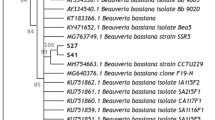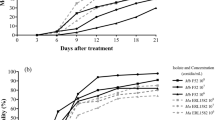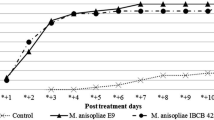Abstract
Nomuraea rileyi, a fungus pathogenic to insects, has been widely used for biological control of agricultural pests in Brazil. This study investigates the effects of N. rileyi, isolates Nr 138, Nr 151, and Nr 177, to eggs, larvae, and engorged females of Rhipicephalus microplus tick. Specimens were immersed in 1 ml of conidial suspension for 3 min, whereas the control group was immersed in 0.01 % Tween 80 water solution. The isolate Nr 138 controlled 67.37 % of ticks when the highest conidial concentration was used, 108 conidia ml−1. The isolate Nr 177 significantly reduced the percentage of hatch of larvae from eggs treated with 108 conidia ml−1. Conversely, the isolate Nr 151 was not virulent to eggs, larvae, or adults. Variability in virulence was observed among the N. rileyi isolates investigated in the current study—Nr 138 was more virulent to engorged females, while Nr 177 was more virulent to unfed larvae. Although N. rileyi proved to be virulent to several stages of R. microplus, the results obtained in this study indicate that N. rileyi does not appear to be a remarkable biological control agent for R. microplus.
Similar content being viewed by others
References
Alves SB (1998) Controle microbiano de insetos. Fealq, São Paulo
Angelo IC (2007) Avaliação dos efeitos in vitro de Isaria farinosa, I. fumosorosea, Paecilomyces lilacinus e Lecanicillium lecani sobre Boophilus microplus. Dissertation, Universidade Federal Rural do Rio de Janeiro
Angelo IC, Fernandes EKK, Bahiense TC, Perinotto WMS, Moraes APR, Terra ALM, Bittencourt VREP (2010) Efficiency of Lecanicillium lecanii to control the tick Rhipicephalus microplus. Vet Parasitol 172:317–322
Arruda W, Lübeck I, Schrank A, Vainstein MH (2005) Morphological alterations of Metarhizium anisopliae during penetration of Boophilus microplus ticks. Exp Appl Acarol 37:231–244
Barros TAM, Evans DE (1989) Ação de gramíneas forrageiras em larvas infectantes do carrapato dos bovinos Boophilus microplus. Pesqui Vet Bras 9:17–21
Bennett GF (1974) Ovoposition of Boophilus microplus (CANESTRINI) (ACARIDA: IXODIDAE). Influence of tick size on egg production. Acarologia 16:53–61
Bittencourt VREP, Massard CL, Lima AF (1992) Uso do Metarhizium anisopliae (Metschnikoff, 1879) Sorokin, 1883, no controle do carrapato Boophilus microplus (Canestrini, 1887). Arq Univ Fed Rural Rio de Janeiro 15:197–202
Bittencourt VREP, Massard CL, Lima AF (1994) Ação do fungo Metarhizium anisopliae (Metschnikoff, 1879) Sorokin, 1883, em ovos e larvas do carrapato Boophilus microplus (Canestrini, 1887). Rev Univ Rural Ser Cienc Vida 16:42–47
Bittencourt VREP, Peralva SLFS, Viegas EC, Alves SB (1996) Avaliação dos efeitos do contato de Beauveria bassiana (Bals.) Vuill. com ovos e larvas de Boophilus microplus (Canestrini, 1887) (Acari: Ixodidae). Rev Bras Parasitol Vet 5:81–84
Bittencourt VREP, Peralva SLFS, Souza EJ, Mascarenhas AG, Alves SB (1997) Ação de dois isolados do fungo entomopatogênico Beauveria bassiana sobre algumas características biológicas de fêmeas ingurgitadas de Boophilus microplus em laboratório. Rev Univ Rural Ser Cienc Vida 19:65–71
Boucias DG, Pendland JC (1984) Nutritional requirements for conidial germination of several host range pathotypes of the entomopathogenic fungus Nomuraea rileyi. J Invertebr Pathol 43:288–292
Davey RB, Osburn RL, Miller JA (1984) Ovipositional and morphological comparisons of Boophilus microplus (Acari: Ixodidae) collected from different geographic areas. Ann Entomol Soc Am 77:1–5
Drummond RO, Gladney WJ, Whetstone TM, Ernst SE (1971) Laboratory testing of insecticides for control of the winter tick. J Econ Entomol 64:686–688
Edelstein JD, Lecuona RE, Trumper EV (2004) Selection of culture media and in vivo assessment of temperature-dependent development of Nomuraea rileyi. Neotrop Entomol 33:737–742
Fernandes EKK, Costa GL, Souza EJ, Moraes AML, Bittencourt VREP (2003) Beauveria bassiana isolated from engorged females and tested against eggs and larvae of Boophilus microplus. Basic Microbiol 43:393–398
Finney DS (1971) Probit analysis. Cambridge, England
Frazzon APG, Junior ISV, Masuda A, Schrank A, Vainstein MH (2000) In vitro assessment of Metarhizium anisopliae isolates to control the cattle tick Boophilus microplus. Vet Parasitol 94:117–125
Glória MA, Daemon E, Faccini JLH, Grisi L (1993) Influencia de diferentes temperaturas sobre a biologia da fase não parasitaria de Boophilus microplus (Canestrini,1887) (Acari: Ixodidae). Rev Bras Parasitol Vet 2:85–91
Grisi L, Massard CL, Borja GEM, Pereira JB (2002) Impacto econômico das principais ectoparasitoses em bovinos no Brasil. Hora Vet 21:23–28
Ignoffo CM, Puttler B, Hostetter DL, Dickerson WA (1981) Susceptibility of the cabbage looper, Trichoplusia ni, and the velvet bean caterpillar, Anticarsia gemmatalis, to several isolates of the entomopathogenic fungus Nomuraea rileyi. J Invertebr Pathol 28:259–262
Jackson CW, Heale JB, Hall RA (1985) Traits associated with virulence to the aphid Macrosiphoniella sanborni in eighteen isolates of Verticillium lecanii. Ann Appl Biol 106:39–48
Melo DR, Reis RCS, Bittencourt VREP (2006) Patogenicidade in vitro do fungo Metarhizium anisopliae (Metschnikoff, 1879) Sorokin, 1883, sobre o carrapato BoophiIus microplus (Canestrini, 1887). Rev Bras Parasitol Vet 15:157–162
Paião JCV, Monteiro AC, Kronka SN (2001) Susceptibility of the cattle tick Boophilus microplus (Acari: Ixodidae) to isolates of the fungus Beauveria bassiana. World J Microbiol Biotechnol 17:245–251
Pekrul S, Grula EA (1979) Mode of infection of the corn earworm (Heliothis zea) by Beauveria bassiana as revealed by scanning electron microscopy. J Invertebr Pathol 34:238–247
Pirali-Kheirabadi K, Haddadzadeh H, Razzaghi-Abyaneh M, Bokaie S, Zare R, Ghazavi M, Shams-Ghahfarokhi M (2007) Biological control of Rhipicephalus (Boophilus) annulatus by different strains of Metarhizium anisopliae, Beauveria bassiana and Lecanicillium psalliotae fungi. Parasitol Res 100:1297–1302
Polar P, Kairo MTK, Moore D, Pegram R, John SA, Roach-Benn C (2005) Comparison of water, oils and emulsifiable adjuvant oils as formulating agents for Metarhizium anisopliae for use in control of Boophilus microplus. Mycopathol 160:151–157
Roberts DW (1981) Toxins of entomopathogenic fungi. In: Burges HD (ed) Microbial control of pests and plants diseases 1970–1980. Academic, London, pp 441–464
Sampaio IBM (2002) Estatística aplicada à experimentação animal. Fepmvz, Belo Horizonte
Santi L, Silva OB, Berger M, Guimarães JA, Schrank A, Vainstein MH (2010) Conidial surface proteins of Metarhizium anisopliae: source of activities related with toxic effects, host penetration and pathogenesis. Toxicon 55:874–880
Schrank A, Vainstein MH (2010) Metarhizium anisopliae enzymes and toxins. Toxicon 56:1267–1274
Srisukchayakul P, Wiwat C, Pantuwatana S (2005) Studies on the pathogenesis of the local isolates of Nomuraea rileyi against Spodoptera litura. Sci Asia 31:273–276
Sujii ER, Carvalho VA, Tigano MS (2002a) Cinética da esporulação e viabilidade de conídios de Nomuraea rileyi (Farlow) Samson sobre cadáveres da lagarta-da-soja, Anticarsia gemmatalis Hübner (Lepidoptera: Noctuidae), em condições de campo. Neotrop Entomol 31:85–90
Sujii ER, Tigano MS, Sosa-Gomes D (2002b) Simulação do impacto do fungo Nomuraea rileyi em populações da lagarta da soja, Anticarsia gemmatalis. Pesq Agrop Brasileira 37:1551–1558
Wharton R, Roulston HWJ (1970) Resistance of ticks to chemicals. Annu Rev Entomol 15:381–404
Acknowledgments
This study was supported by grants from the Conselho Nacional de Desenvolvimento Científico e Tecnológico (CNPq) and Fundação Carlos Chagas Filho de Amparo à Pesquisa do Estado do Rio de Janeiro (FAPERJ). We also thank the Coordenação de Aperfeiçoamento de Pessoal de Nível Superior (CAPES). V.R.E.P. Bittencourt is a CNPq researcher (1C).
Author information
Authors and Affiliations
Corresponding author
Rights and permissions
About this article
Cite this article
Perinotto, W.M.S., Terra, A.L.M., Angelo, I.C. et al. Nomuraea rileyi as biological control agents of Rhipicephalus microplus tick. Parasitol Res 111, 1743–1748 (2012). https://doi.org/10.1007/s00436-012-3018-3
Received:
Accepted:
Published:
Issue Date:
DOI: https://doi.org/10.1007/s00436-012-3018-3




